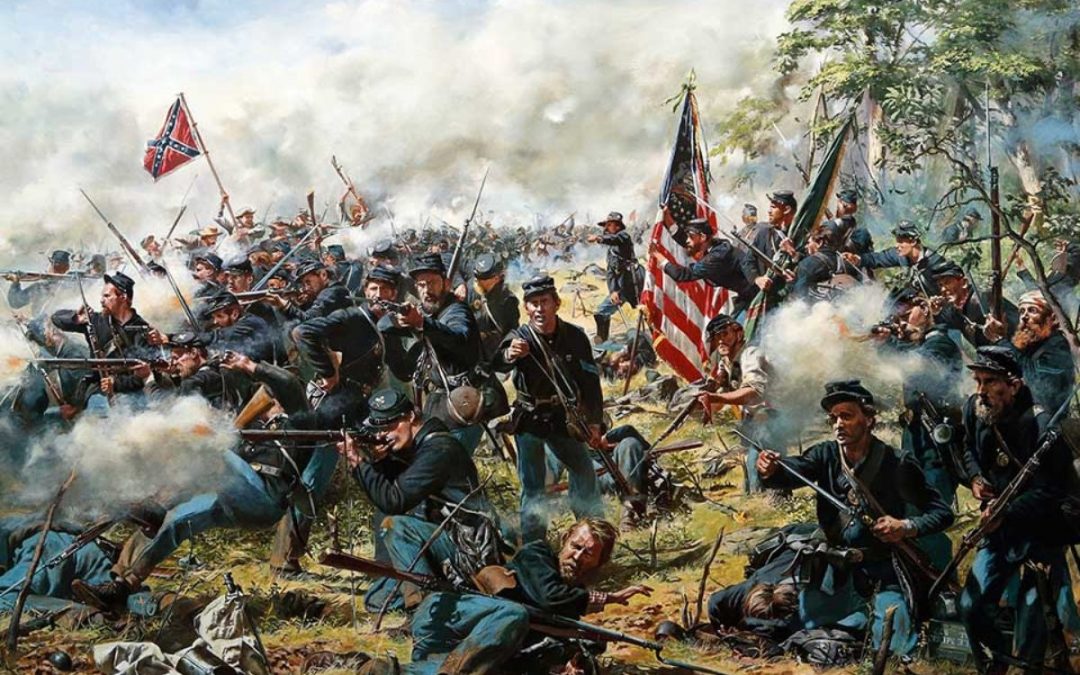“Colonel,” Chamberlain said. “One thing. What’s the name of this place? This hill. Has it got a name?”
It’s a line from Michael Shaara’s The Killer Angels, and it was later translated into film for the movie, Gettysburg. Of course, most Civil War buffs know that Chamberlain and the 20th Maine were defending Little Round Top on July 2, 1863, at that point in the Gettysburg saga, but it brings up a good reminder that the military men didn’t always know the names of landmarks or positions on their fighting ground. Sometimes, locals and soldiers gravitated toward the same name for places—like “Sunken Road.” Other times, the military gave new names to locations or made infamous a traditional name.
Little Round Top and Devil’s Den, located south of the town of Gettysburg, were already part of local lore and legend before the battle horrors and memory now associated with the locations. So, how were these two places viewed “on the eve of war” and in the years before the armies came?
A rocky crag peaked, shadowing the Adams County farms about 2.5 miles south of Gettysburg went by a variety of names among the families in the area. The lower eminence (later dubbed “Little Round Top”) was called Sugar Loaf Hill, Granite Spur (particular the western side), Rock Top Hill, Stoney Ridge, and Long Hill.[i] Sometime in the early 1860’s the western face of the high ground was logged, allowing someone standing on the crest to easily overlook Plum Run Valley, Devil’s Den, and the farms beyond to the west.[ii]
Devil’s Den is a name associated with the fierce fighting in 1863 that occurred in the huge formation of rocks near the base of Little Round Top. However, the locals used that name long before the night fighting and fierce, devilish combat. How did Devil’s Den get its name? The location seems to have started out simply called “The Big Rocks,” but then the legends diverge into a variety of stories. The common thread seems to be a “devilish” animal living in the rocks. Some stories suggest a monstrous snake inhabited the rocks. Other tales remembered a rowdy, devilish bear that called the rocks home and made raids into the farming community. “Raccoon Den” was the name that farmer Emanuel Bushman called the site and claimed the furry beasts had attacked at least one peaceful passerby.[iii]
The Big Rocks and immediate surrounding area weren’t good for farming, but seemed to intrigue the farmers. Joseph Sherfy (owner of the battle-infamous Peach Orchard) wrote that lightning split one of the 20-ton boulders. He didn’t specify if he saw it, but clarified that it happened during his lifetime.[iv]
Devil’s Den with its bugbear stories stood out in the landscape—an unfarmable, unprofitable site. Sugar Loaf Mountain was somewhat similar to the locals, except for the profit made by logging part of the high ground. These local landmarks became famous during the Battle of Gettysburg, and local lore slipped to the far background as the bloody story took the spotlight.
But those days were still months away and in the unknown future from the perspective of April 1861. Instead Devil’s Den and Granite Spur were the habitations for wildlife and the places of mild, scary stories. The sun set to the west with the breathtaking descent, but the red-orange glow did not have the symbolism that we see from the same sites of natural wild and beauty now tinted with the bloody stories.
Yes, the hill and the rock pile have names. Little Round Top and Devil’s Den. “Seminary Ridge, the Peach-Orchard, Cemetery, Culp, and Wolf Hill, Round Top, Little Round Top, humble names, henceforward dear and famous,–no lapse of time, no distance of space, shall cause you to be forgotten.” (Edward Everett, November 19, 1863)
Sources:
[i] Gregory A. Coco. A Strange & Blighted Land: Gettysburg: The Aftermath of a Battle. (Gettysburg: Thomas Publications, 1995). Page 26
[ii] Harry W. Pfanz. Gettysburg: The Second Day. (Chapel Hill: University of North Carolina Press, 2011). Page 124.
[iii] Gregory A. Coco. A Strange & Blighted Land: Gettysburg: The Aftermath of a Battle. (Gettysburg: Thomas Publications, 1995). Page 37.
About Sarah Kay Bierle
I’m Sarah Kay Bierle, author, speaker, and researcher. Past and present, everyone has a story. What will we discover and discuss?




